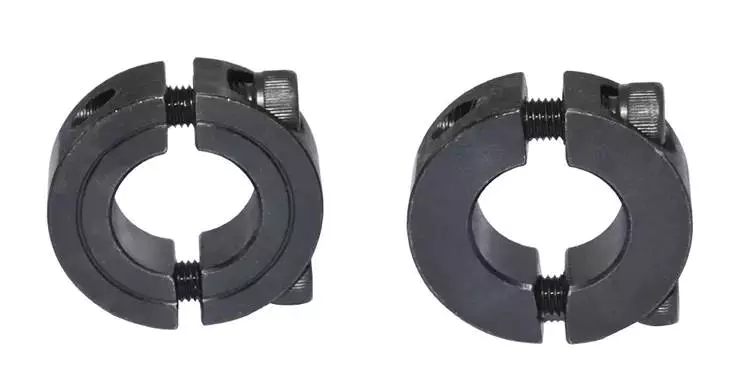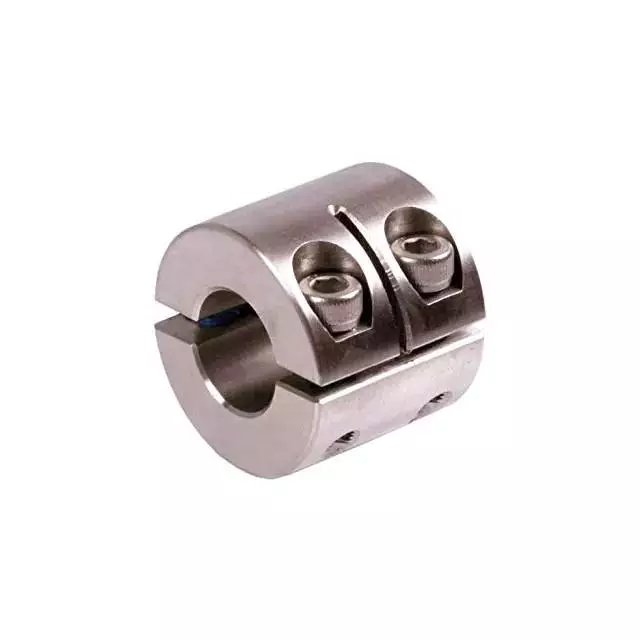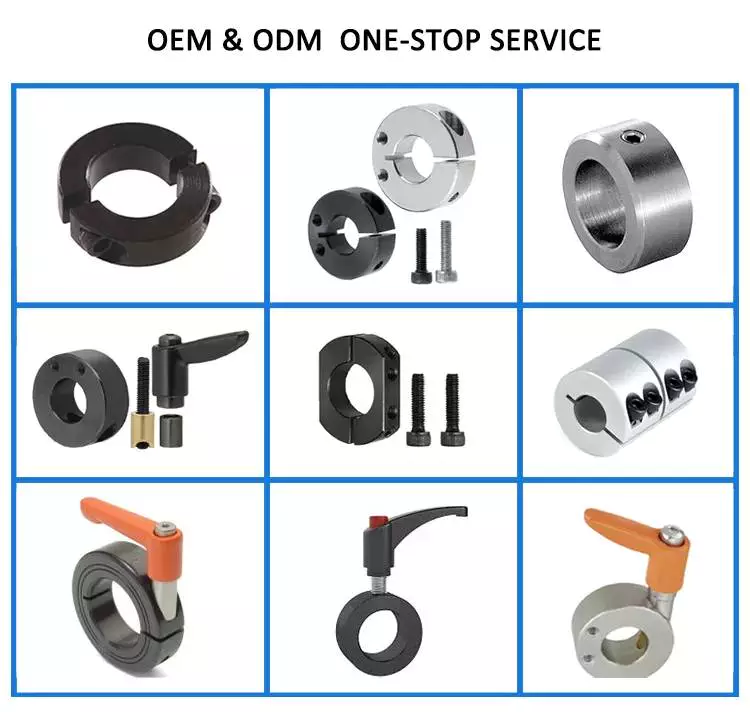Applicable Industries: Industry
Structure: Flexible
Material: Aluminum, Aluminium
Coatings: Stainless Steel
Torque Capacity: Min: 1 in-lbs, Max: 3.5 in-lbs
Model Number: FAN-A110
Bore Tolerance: +.002 in / +.0005 in
Screw Material: 18-8 300 Series Stainless Steel
Screw Finish: Bright
Temperature: -40°F to 200°F -40°C to 93°C
Weight (lbs.): 0.0560
Axial Load: Min: 30 lbs, Max: 60 lbs
Name: Quick Clamping Shaft Collar
Application: Industrial Equipment
Quality: High Precision
Packaging Details: Standard Export Packaging
Port: HangZhou/ZheJiang Port
Aluminum Quick Release 1.496″ OD And 0.394″ Width 5/8″ Quick Clamping Shaft CollarFanovo FQCL is a quick clamping shaft collar. No tools are required to install or remove allowing for quick installations and adjustments while reducing downtime. It is designed for light duty stationary or low rotating applications where frequent change outs of items including media, CZPT rails, or other setup fixturing is required. FQCL has an integral handle that can be actuated using finger power only for easy postioning adjustments. The screw can be adjusted to be compatible with wider shaft tolerances and provide a range of axial holding power. Hardware is metric and tests beyond DIN 912 12.9 standards for maximum torque capabilities. It is RoHS2 and REACH compliant and manufactured in our ZHangZhoug,China under strict controls using proprietary processes.
| Name | Aluminum Quick Release 1.496″ OD And 0.394″ Width 5/8″ Quick Clamping Shaft Collar |
| Material | 18-8 300 Series Stainless Steel |
| Temperature | -40°F to 200°F |
| Weight (lbs.) | 0.0560 |
| Material Specification | Body: 6061-T651 Aluminum Bar, Handle: 6063-T651 Aluminum |
Shaft collar Material Test ReportFanovo imported Spectrometer machines for metal test, keep materials of each order meet Customers’ need. The metal includes stainless steel 304, 316L, lead free NSF brass, CW 617, Monel 400, etc.
Material Analysis Equipment All incoming material before production will be tested by material analysis machine
Material Test Report Material test report will be shipped with each order, Fanovo guarantees the materials qualified for customers.
Spectrometer Machine for Material Test Fanovo is capable to test brass, stainless steel, Aluminum etc. Fanovo Images Incoming Quality ControlFanovo will do 100% inspection for incoming material, brass bar, stainless steel, steel etc.
Lean ManufacturingIPQC department will inspect the process of Turning&milling, Fanovo do production accord to DWG.
Imported CNC 5-axis machining involves using a CNC to move a part along 5 different axes simultaneously
6 Pcs 400T forging machine
Automatic Assembly for valves
5S management assembly Line
CertificationFanovo are carrying out Total Quality Management and obtained ISO 9001 for management The quality responsibility is divided into quality divisions ( SQC, IQC, IPQC, FQC, OQC). Fanovo promises Just-in-time delivery and fine manufacturing for our customers. Meanwhile Fanovo has the certification of NSF/ANSI 61, UPC/ CE for main products including brass valves, fittings, couplings, etc.
Delivery PackagingFanovo’s delivery packing by sea is in Carton Box and pallet. Ensure your shipment arrives safely and on time by packing your goods well. It’s 1 of the most important things Fanovo can do to reduce the risk of delays and damage during transit.
Inner Box :
White Box
or Color Box
Carton Box:
Corrugated Box
With Item Label
Pallet Packing:
By Sea/ By Air
Sea shippingFanovo recommend to ship by sea if quantity is big that saves much freight for customers.
DHL/ UPS/ FEDEX/TNT/ Special Air Delivery Good for sample delivery and small volume
FAQQ: Are you trading company or manufacturer ?
A: We are a manufacturer with our own trading company in ZheJiang .Q: How long is your delivery time?
A: Generally it is 2-10 days if the goods are in stock. or it is 20-40 days if the goods are not in stock, it is according to quantity.Q: Do you provide samples ? is it free or extra ?
A: Yes, we could offer the sample for free charge but do not pay the cost of freight.Q: What is your terms of payment ?
A: Payment=1000USD, 30% T/T in advance ,balance before shippment.Q: Can you customize products for your customers?
A: Yes, Customized service is 1 of our core business, we have no small MOQ request.
Q:Will you do 100% inspection before Shipment?
A: Our QC will do 100% inspection and we will take the 100% claims if defective.
Contact us
Choosing a Shaft Collar
The shaft collar is a simple machine component used in a variety of power transmission applications. They are most often found on gearboxes and motors. Their simple design makes them an easy component to install and remove. Among other uses, shaft collars are used as bearing faces, mechanical stops, and locating components.
Clamp-style shaft collars
Clamp-style shaft collars fix many of the problems associated with set-screw collars. Available in two-piece and one-piece designs, these collars compress the shaft and lock into place. This allows for a uniform distribution of force on the shaft. Clamp-style shaft collars provide more holding power than set-screw collars, but they work best under consistent pressure. Clamp-style shaft collars also work better against negative forces, as they have a separate, un-tightened side.
Clamp-style shaft collars feature mounting holes in the outer diameter. Like clamp-style collars, mountable shaft collars can be installed on adjacent assemblies, but the mounting method does not affect holding power. Mountable shaft collars are commonly used in mounting sensor brackets. They may have rounded or flat outer diameters to accommodate the mounting process. Mountable shaft collars may also have tapped or flat holes to facilitate installation.
Quick-clamp shaft collars have the same functionality as clamp-style collars, but feature a removable lever. They are typically quick-to-install and do not mar the shaft. Quick-clamping collars are especially beneficial in applications that require light-duty torque. They also make for quick and easy adjustments.
Heavy-duty shaft collars feature larger outer diameters, a wider face, and a larger screw. These collars are ideally suited for d-shafting and can offer greater holding power than set-screw collars. These collars are typically manufactured from high-strength 2024 aluminum.
Clamp-style shaft collars can be used in many different applications. They can be used for a variety of applications, including bearings, and are especially suited for rotary machines. However, there are some drawbacks. While they may not be as flexible as set-screw collars, they can still perform well under constant loads. One drawback is that they tend to loosen under shocks and reduce the holding power of clamping hardware.
Another advantage of clamp-style shaft collars is that they do not mar the shaft and allow for easy positioning adjustments. Furthermore, they are easier to install and offer greater holding power than set-screw collars. These collars are made from high-quality materials with tight tolerances and are available in different bore sizes.
Clamp-style shaft collars are the most common type of shaft collars. They can be two-piece or one-piece. Among these, two-piece collars are the most convenient option. One-piece collars are hard to move, and two-piece collars have a hinge on one side and a clamp-style collar on the other side.
The materials used in Clamp-style shaft collars play a crucial role in their overall performance. They should be strong, corrosion-resistant, and have good holding power. They should also be able to withstand high temperatures. The most common materials used for shaft collars are steel and aluminum. Some types are made from stainless steel, while others are made from engineered plastic.
Clamp-style shaft collars can come in two pieces or single-piece designs. The smaller one-piece collars usually have a back-cut opposite the clamp cut, which reduces the cross-sectional area at the hinge point. This reduces the amount of force required to clamp the collar, which makes it easier to use stronger screws.
Aluminum, carbon steel, and stainless steel shaft collars
When choosing a shaft collar, you should consider the material it is made of. You can purchase collars made of carbon steel, aluminum, or stainless steel. Each of these materials has its benefits and disadvantages. Steel is more durable than aluminum and tends to provide better holding power. Aluminum, on the other hand, is lighter and has a favorable strength-to-weight ratio. The material you choose should depend on your specific needs, such as corrosion resistance or weight.
Mountable shaft collars are used to mount sensors, fixtures, and other assemblies. These collars are available with outer diameter holes, flats, or quick-release designs. The material used to make these collars varies, with standard models made of 1215 lead-free steel and 2024 aluminum.
When choosing shaft collars, take into account the material and surface treatment. Different materials offer different properties, which will determine the performance of the collar. In addition to material, each shaft collar comes with a different holding power. Holding power is a key factor in choosing a shaft collar because it determines the amount of load it can withstand without slipping. The holding power depends on the screw size, the bore size, and the bulk of the collar.
Aluminum, carbon steel, and stainless steel shaft-collars can come in various styles. CZPT, for example, offers standard shaft collars in hex and d-bore profiles. Hex collars provide extra holding power and are better than set screws. Additionally, they do not mar the shaft and provide a better grip.
Another type of shaft collar is the quick-clamp shaft collar. These features allow users to install and remove them with ease. The quick-clamp collar has a handle that allows the user to quickly adjust it. While these shaft collars are designed for light duty applications, they are not recommended for heavy-duty or high-RPM applications.
Shaft collars are simple yet versatile components. They are used for various applications, including mechanical stops, stroke limiters, and retainers. They can also be used to align and space other components. Shaft collars are widely used in gearbox assemblies, flagpoles, and medical instruments, among others.
Two-piece shaft collars offer the same benefits of one-piece shaft collars, but offer additional convenience and versatility. They are easier to install and disassemble, reducing installation and labor costs. They also offer superior holding power. They also feature a threaded bore that acts as a positive mechanical stop when the shaft is rotated.
Over-torqueing shaft collars
Shaft collars are often used to secure components on shafts or other surfaces. They also provide an easy way to adjust the positioning of motor assembly components. Many different types of shaft collars are available to meet the specific needs of different applications. These include round, hexagonal, square, and D-bore collars.
The design of shaft collars must account for the load they will support. Some collars are made of metals, while others are made of plastic or composite materials. Typically, shaft collars are made of steel, but can also be made from aluminum or alloyed steel. Some are coated with zinc.
Shaft collars are available in one-piece and two-piece designs. Single-piece collars are designed to fit securely around a shaft, while double-piece collars allow for greater clamping force. These collars can be assembled anywhere along the shaft and can be installed between two pieces. They are available in different bore configurations and can be customized to meet your specific application.
Clamp style collars are easy to install and disassemble, and have a larger holding force than one-piece collars. These collars are also more shock-load resistant. They also don’t mar shaft surfaces, unlike setscrews. They can also be easily adjusted without damaging the shaft. Another style of collar is the quick-clamping style. This type of collar doesn’t mar the shaft, and is easily installed and removed without tools. These are best for light-duty applications.
When choosing a shaft collar, you should consider the tolerance of the shaft. It is important to select a shaft with a tight tolerance. The shaft’s hardness should not be greater than Rockwell C35. A wide tolerance will affect the holding power of the collar. If the shaft is undersized, you may need to use a screwdrive to slide the collar on the shaft.
Shaft collars are a versatile component with many different applications. They can secure industrial railings or serve as positioning devices in medical equipment. They are also widely used in automation machinery. They are used to protect cylinders and actuators and to ensure alignment between components. For this reason, they are very versatile and adaptable.
Clamp-style collars work well under constant loads, but they may need assistance during impact loads. Shock loads can be difficult to avoid, especially if the mass is small. Clamp-style collars with an undercut in the shaft help to resist the impact of shock. Moreover, they offer positive stops in both axial directions.
Clamp-style shaft collars are a good alternative for set-screw collars. They are easy to install and prevent shaft damage. They also come with an added advantage of being easy to adjust. Clamp-style shaft collars have double the holding power of set-screw collars.
In addition to holding components, shaft collars can also function as spacers and limit shaft movement. They are essential for many applications. They are commonly used in motors and gearboxes to ensure correct positioning for power transmission. They are also used to control shaft movement in reciprocating applications.

editor by czh